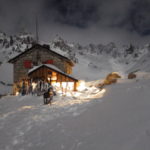“The practical rationale for having avalanche education as a recreationist or professional is to manage risk by understanding what conditions and terrain exposure lead to hazard.”- Kirk Bachman, American Avalanche Association
Avalanche education in the United States is somewhat of a mixed bag, but most mountain travelers have either some familiarity with terminology, formal training, or hear enough anecdotal evidence to maintain vigilance. Whether you are a seasoned veteran or just beginning to think about going beyond the gates, the time to pay attention is now.
The original design of the Awareness>Level 1>Level 2>Level 3 timeline worked very well for many years and the providers teaching this progression did a lot of good for the community. As the tribe grew, it was noticed that some users were either being under-served or overwhelmed.
“In the old system I had professional ski patrollers and intermediate backcountry travelers as students on a Level 2 course. This made it difficult to deliver what the audience needed as there was a wide variety of experience and expectations,” says Eeva Latosuo of the Alaska Avalanche School and Chair of the AAA Education Committee. Thus, a proposal for change came to the fore and has undergone continuing refinement to better serve both segments.
Starting in late 2013, the American Avalanche Association (AAA) and its members began discussions on how to restructure the current landscape of avalanche education. Countless meetings between education providers, guide associations, ski areas, government agencies, and non-profits have taken place to reach consensus on what the future of the program looks like and how it will benefit each user group. Fall 2017 will see all the hard work and planning finally come to fruition.
“The Pro/Rec Project really addresses consistency of communication among the public, education programs, and professionals– to exchange information through a common platform of language and concepts,” says Kirk Bachman, member of the AAA Education Committee and founder of Sawtooth Mountain Guides.
Avalanche Awareness is the best starting point for gaining a basic understanding of what avalanche terrain looks like and how to mitigate exposure through avoidance. This is how the Know Before You Go Program (kbyg.org) is set up. The local avalanche centers are on the leading edge of this front and have achieved national success by creating a uniform message of: Get the Gear, Get the Training, Get the Forecast, Get the Picture, and Get Out of Harms Way.
Level 1 Avalanche Training is still the gold standard for anyone going into the backcountry. This course centers on the importance of gathering information and developing a plan with your partners prior to heading into the field. Utilizing avalanche bulletins to understand the avalanche problem will continue to be a focal point of the curriculum. By discussing the moving parts and addressing questions about the snowpack, students are able to start selecting appropriate terrain for their group. Basic avalanche companion rescue remains a component of Level 1, but more focus is going to be given to decision-making and group dynamics.
Avalanche Rescue is a new, stand-alone course that provides more time for practicing all the elements of rescue: beacon search strategies, probing and shoveling techniques, and patient stabilization after recovery. There will be no pre-requisites for this course and the goal is to give students problem solving techniques to respond to an avalanche involvement within their own group or a nearby party. Creative scenarios and go-speed exercises are incorporated to build the muscle memory and mental checklists used during an actual response. One may look at perhaps the greatest testament to this kind of training by visiting Avalanche Canada’s Rescue at Cherry Bowl microsite (avalanche.ca/cherry-bowl).
Level 2 Avalanche Training steps up and builds on the skills learned in the previous courses. Students must have an existing Level 1 prior to 2017 or a new Level 1 and Avalanche Rescue to gain entry into this course. Group selection and leadership, effective linking of avalanche problems to terrain selection, targeted observations, advanced decision-making skills with or without an avalanche bulletin, travel techniques, and improved communication strategies lie at the heart of this training.
Sarah Carpenter, co-owner of American Avalanche Institute, weighs in on a major component of the new model – “The most influential and beneficial change has been talking more about group dynamics, and why people are involved in accidents. We talk about how to build a team and how to give each member a voice. By studying accidents, we understand that people need to know some snow science, but they also need to practice teamwork and communication.”
Moving beyond the recreational stream is also an option for those interested in joining the professional community. After a student has gone through Level 1 and Avalanche Rescue, they will need to meet additional criteria to apply for the Pro 1. Upon completion, professionals can then take their skills into the workplace and become more effective members of a team. Pro 2 is the next progression after further criteria are met. This course is similar to the previous Level 3 and focuses on training decision makers in operational settings.
The entire Professional Avalanche Training program is centered on improved worker safety and developing consistent skill sets across the industry. Evaluation components are also built into the program to ensure participants represent an agreed upon standard when leaving their respective course. Visit americanavalancheassociation.org/professional-training for more info regarding these specifics.
The new progression represents a paradigm shift in avalanche education that is geared towards raising the bar for all participants. Fatalities in the backcountry and the workplace can be mitigated through better communication and higher standards. This is the goal and everyone’s participation at every step is critical. Check out avalanche.org as a one-stop shop for links to forecast centers and course providers as you prepare for this winter.














